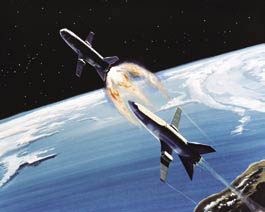1.1 GENESIS OF THE SPACE TRANSPORTATION SYSTEM
1.1 Genesis of the Space Transportation System
― スペースシャトル宇宙輸送システムの誕生 ―
― スペースシャトル宇宙輸送システムの誕生 ―
The origins of the Space Shuttle Program date to discussions on what should follow Project Apollo, the dramatic U.S. missions to the moon.*1 NASA centered its post-Apollo plans on developing increasingly larger outposts in Earth orbit that would be launched atop Apollos Saturn V booster. The space agency hoped to construct a 12-person space station by 1975; subsequent stations would support 50, then 100 people. Other stations would be placed in orbit around the moon and then be constructed on the lunar surface. In parallel, NASA would develop the capability for the manned exploration of Mars. The concept of a vehicle ュ or Space Shuttle ュ to take crews and supplies to and from low-Earth orbit arose as part of this grand vision (see Figure 1.1-1). To keep the costs of these trips to a minimum, NASA intended to develop a fully reusable vehicle.*2
スペースシャトルプログラムの起源は、月を目指した壮大なアポロ計画に続くミッションを巡る議論に端を発します。*1 NASAは 巨大なサターンV型ロケットを使って、軌道上に拡張可能な拠点を築くことを、ポストアポロ計画の中心に置きました。1975年までに12人が滞在できる宇宙ステーションを建設することを希望したのです。このステーションは将来的に50人、さらに100人の滞在が可能なように拡張される予定でした。また、もう1つの宇宙ステーションを月軌道上に建設し、後に月面にも基地を建設することも計画されていました。さらに、これらの建設計画と平行して、NASAは火星への有人探査を可能にする技術開発を行うことになっていました。宇宙機のコンセプト―つまりスペースシャトル―は、乗員と補給物資を地球の低軌道に運ぶものとして、これらの全体計画の一部として提唱されたものでした(図1.1-1)。コストを最小限に押さえるために、NASAは完全に再利用可能な機体を開発することを計画していました。*2

Figure 1.1-1. Early concepts for the Space Shuttle envisioned a reusable two-stage vehicle with the reliability and versatility of a commercial airliner.
図1.1-1:スペースシャトルの初期のコンセプト。
旅客機なみの信頼性と多機能性を備えた、2段構成の再利用型宇宙機。
旅客機なみの信頼性と多機能性を備えた、2段構成の再利用型宇宙機。
NASAs vision of a constellation of space stations and jour-neying to Mars had little connection with political realities of the time. In his final year in office, President Lyndon Johnson gave highest priority to his Great Society programs and to dealing with the costs and domestic turmoil associated with the Vietnam war. Johnsons successor, President Rich-ard Nixon, also had no appetite for another large, expensive, Apollo-like space commitment. Nixon rejected NASAs am-bitions with little hesitation and directed that the agencys bud-get be cut as much as was politically feasible. With NASAs space station plans deferred and further production of the Saturn V launch vehicle cancelled, the Space Shuttle was the only manned space flight program that the space agency could hope to undertake. But without space stations to ser-vice, NASA needed a new rationale for the Shuttle. That ra-tionale emerged from an intense three-year process of tech-nical studies and political and budgetary negotiations that attempted to reconcile the conflicting interests of NASA, the Department of Defense, and the White House.*3
しかし、このNASAが計画した複数の宇宙ステーションと火星への旅は、当時の政治的な現実から乖離したものでした。リンドン・ジョンソン大統領は、その任期最後の年、彼の「偉大なる社会(Great Society)」政策と、ベトナム戦争に関連した予算と国内での一連の騒動を何とかすることに心血を注ぎました。またジョンソンの後任である、リチャード・ニクソン大統領は、高価で規模の大きい、アポロのような宇宙計画の推進にまったく興味が無かったのです。ニクソンはNASAの大望をほとんど躊躇無く却下し、NASAの予算を政治的に現実的なレベルまでカットしたのです。宇宙ステーションの計画は延期され、追加のサターンV型ロケットの建造はキャンセルされました。唯一、NASAが実行するのぞみのある有人宇宙飛行計画はスペースシャトルだけだったのです。しかし、補給を行うべき宇宙ステーションがない以上、NASAはシャトルを作るための新しい根拠が必要でした。この「根拠」は、さらなる3年の技術研究と、NASA・国防総省・ホワイトハウスという3者を政治的かつ予算的な面で和解させるための交渉の中から生まれたのです。*3
*1 George Mueller, Associate Administrator for Manned Space Flight, NASA, "Honorary Fellowship Acceptance," address delivered to the British Interplanetary Society, University College, London, England, August 10, 1968, contained in John M. Logsdon, Ray A. Williamson, Roger D. Launius, Russell J. Acker, Stephen J. Garber, and Jonathan L. Friedman, editors, Exploring the Unknown: Selected Documents in the History of the U.S. Civil Space Program Volume IV: Accessing Space, NASA SP-4407 (Washington: Government Printing Office, 1999), pp. 202-205.
*2 For detailed discussions of the origins of the Space Shuttle, see Dennis R. Jenkins, Space Shuttle: The History of the National Space Transportation System ュ The First 100 Missions (Cape Canaveral, FL: Specialty Press, 2001); T. A. Heppenheimer, The Space Shuttle Decision: NASAs Search for a Reusable Space Vehicle, NASA SP-4221 (Washington: Government Printing Office, 1999; also published by the Smithsonian Institution Press, 2002); and T. A. Heppenheimer, Development of the Space Shuttle, 1972-1981 (Washington: Smithsonian Institution Press, 2002). Much of the discussion in this section is based on these studies.
*3 See John M. Logsdon, "The Space Shuttle Program: A Policy Failure?" Science, May 30, 1986 (Vol. 232), pp. 1099-1105 for an account of this decision process. Most of the information and quotes in this section are taken from this article.
*2 For detailed discussions of the origins of the Space Shuttle, see Dennis R. Jenkins, Space Shuttle: The History of the National Space Transportation System ュ The First 100 Missions (Cape Canaveral, FL: Specialty Press, 2001); T. A. Heppenheimer, The Space Shuttle Decision: NASAs Search for a Reusable Space Vehicle, NASA SP-4221 (Washington: Government Printing Office, 1999; also published by the Smithsonian Institution Press, 2002); and T. A. Heppenheimer, Development of the Space Shuttle, 1972-1981 (Washington: Smithsonian Institution Press, 2002). Much of the discussion in this section is based on these studies.
*3 See John M. Logsdon, "The Space Shuttle Program: A Policy Failure?" Science, May 30, 1986 (Vol. 232), pp. 1099-1105 for an account of this decision process. Most of the information and quotes in this section are taken from this article.